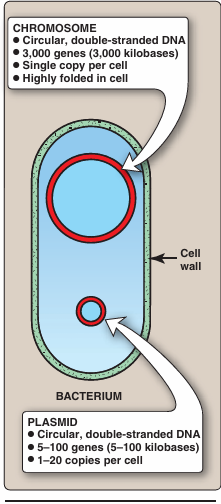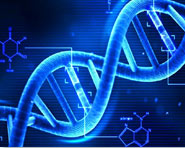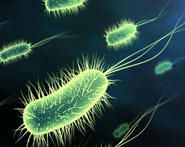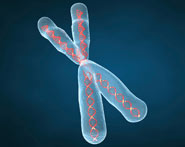


 النبات
النبات
 الحيوان
الحيوان
 الأحياء المجهرية
الأحياء المجهرية
 علم الأمراض
علم الأمراض
 التقانة الإحيائية
التقانة الإحيائية
 التقنية الحيوية المكروبية
التقنية الحيوية المكروبية
 التقنية الحياتية النانوية
التقنية الحياتية النانوية
 علم الأجنة
علم الأجنة
 الأحياء الجزيئي
الأحياء الجزيئي
 علم وظائف الأعضاء
علم وظائف الأعضاء
 الغدد
الغدد
 المضادات الحيوية
المضادات الحيوية|
Read More
Date: 2025-02-02
Date: 2025-01-15
Date: 2025-01-15
|
The genome of an organism is defined as the totality of its genetic material. For bacteria, the genome often consists of a single chromo some that carries all of the essential genes and one or more varieties of plasmid that generally carry nonessential genes (Figure1).

Figure 1 The bacterial genome. [Note: Helical double-stranded DNA is shown as two concentric circles.]
A. The chromosome
All of the essential genes and many nonessential genes of the bacterium are generally carried on a single, long piece of circular, double-stranded DNA. This molecular structure is called the “chromosome” by analogy with the heredity-carriers of eukaryotic cells. Most bacteria have chromosomes that contain 2,000 to 4,000 genes.
B. Pathogenicity islands
Pathogenicity islands are discrete genetic elements that encode virulence factors, such as toxins, adhesins, secretion systems, and iron transport proteins. These islands, which range in size from 10 to 200 kB, can be horizontally transferred between bacteria, resulting in enhanced virulence and fitness in the recipient. [Note: Horizontal gene transfer is any process (such as transformation, transduction, or bacterial conjugation) in which an organism incorporates genetic material from another organism without being the progeny of that organism. By contrast, vertical transfer occurs when an organism receives genetic material from its ancestor, for example, a species from which it has evolved.] Pathogenicity islands differ from the rest of the chromosome in G+C content and are usually flanked in the recipient's chromosome by repeated sequence elements or genes that encode tRNAs.
C. Plasmids
Typically, bacteria contain small DNA circles (plasmids), which range in size from 1.5 kilobase (kb) pairs to 120 kb pairs (less than one tenth the size of the bacterial chromosome). Plasmids replicate independently of the chromosome and can exist in the cell as one copy or as many copies. Plasmids can carry genes that encode toxins or proteins that promote the transfer of the plasmid to other cells but usually do not include genes that are essential for cell growth or replication. Many plasmids contain mobile DNA sequences (transposons) that can move between plasmids and between plasmids and the chromosome . Transposons, the repository for many antibiotic resistance genes, are responsible for the ability of some plasmids to integrate into the chromosome



|
|
|
|
التوتر والسرطان.. علماء يحذرون من "صلة خطيرة"
|
|
|
|
|
|
|
مرآة السيارة: مدى دقة عكسها للصورة الصحيحة
|
|
|
|
|
|
|
قسم صناعة الشبابيك يواصل أعمال تنصيب شباك سرداب الإمام الحسين (عليه السلام)
|
|
|